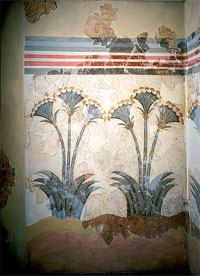Minoan Thera Wallpainting Exhibition: Sea Daffodils, 17th C. BCE
"House of the Ladies
Room 1, West section,
South wall, H. 2.70 / W. 1.75 m.
West wall, H. 2.70 / W. 2.10 m.
North wall, H. 2.70 / W. 1.73 m.
Three stemmed, blossoming plants are drawn in the middle zone of the wall. The lower zone is painted in a reddish-yellow colour. The upper zone is rendered with nine narrow bands of three alternating colours.
The identification of these plants has caused much academic debate. Since the late 1960s, they have been recorded as sea-lilies. Sea-lilies (Pancratium Maritimum L.) still grow on the beach and seaside of Santorini, blooming in late summer.
More recent studies have concluded that these flowers are more likely to be papyrus (Cyperus Papyrus). Not only do the Theran stylistic renditions of these flowers have parallels in Egyptian papyrus imagery, but also evidence at the Archaeological Museum at Chania, Crete, suggests the existence of papyrus in Crete during the Bronze Age.
Furthermore, the height of the flowers, as depicted in the wall-paintings, indicate a scale better suited to a papyrus than to a sea-lily. The sea-lily grows to a maximum height of only 30-40 cm., while the papyrus grows to up to 3 m. and displays a symmetry equivalent to the flowers in this wall-painting."
-taken from therafoundation link below
 |
| Minoan Thera Wallpainting Exhibition: Sea Daffodils, 17th C. BCE. |
 |
| Continued... |
 |
| Continued... |
Source/Quote:
https://web.archive.org/web/20120307130607/http://www.therafoundation.org/wallpaintingexhibition/sea-daffodils/wallpainting
https://fi.m.wikipedia.org/wiki/Tiedosto:Wall_paintings_from_the_House_of_the_Ladies.jpg
https://www.pinterest.co.uk/pin/440226932311293753/
http://apuntes.santanderlasalle.es/arte/prehelenico/cretense/akrotiri_casa_senoras.jpg





Comments
Post a Comment